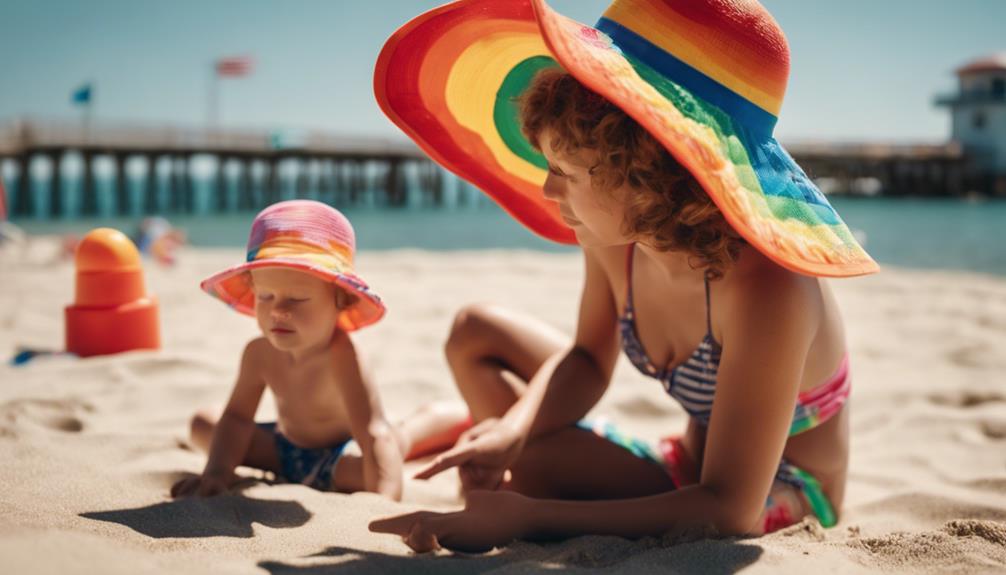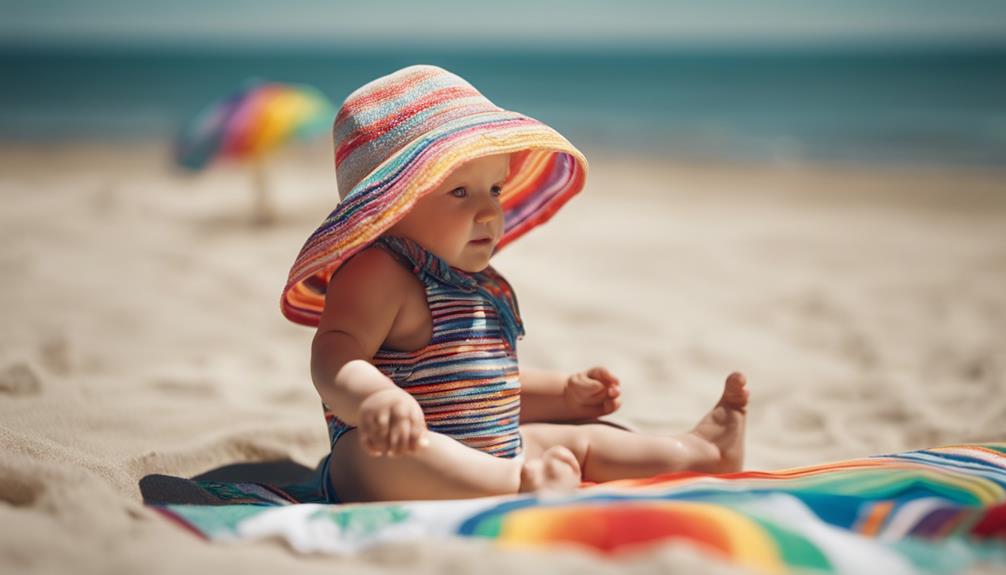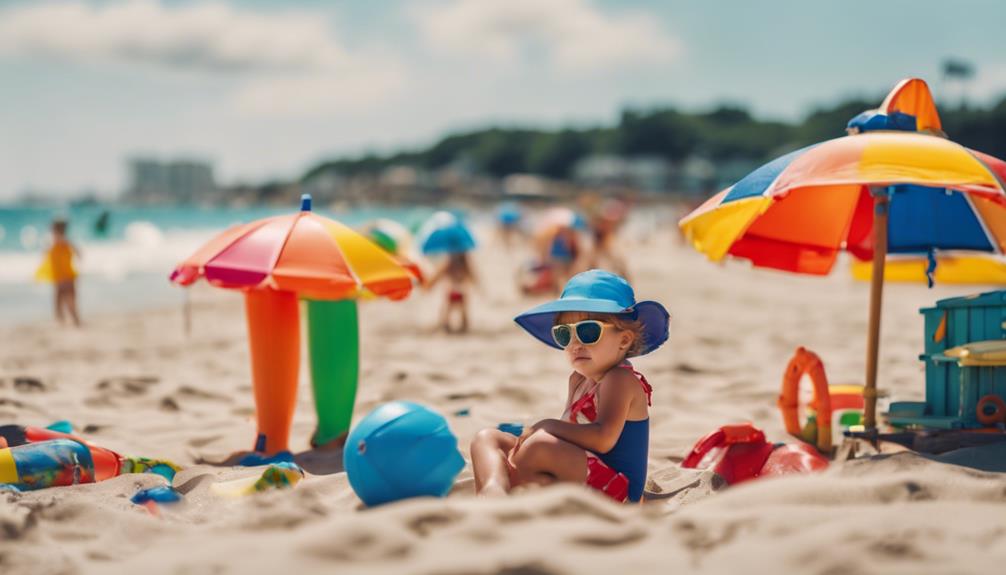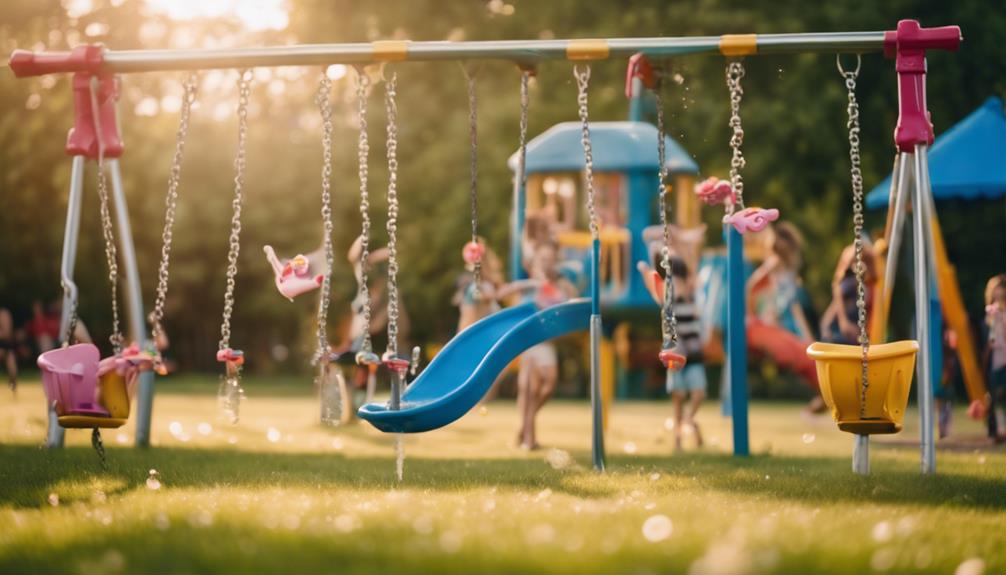Sunburn poses significant risks for kids, so it's essential to stay informed. Children's skin is thinner and more vulnerable to UV rays, making them susceptible to severe sun damage. Even mild sunburn can lead to long-term consequences like skin cancer. Keep an eye out for symptoms—redness, pain, or blisters—and act quickly for relief. Always use broad-spectrum sunscreen, protective clothing, and limit outdoor play during peak hours. By understanding these dangers and implementing preventive measures, you can help safeguard your child's skin for the future. There's much more to explore about effective strategies and care options to keep your little ones safe from the sun.
Key Takeaways
- Children's skin is more susceptible to UV damage, increasing their risk of sunburn and long-term skin issues, including skin cancer.
- Mild sunburn symptoms include redness and pain, while severe cases may involve blisters and systemic symptoms like fever or confusion.
- Immediate relief measures include moving to shade, applying cool compresses, and using pain relievers like ibuprofen or acetaminophen.
- Effective prevention strategies involve applying broad-spectrum sunscreen, dressing in protective clothing, and limiting outdoor play during peak UV hours.
Understanding Sunburn in Children
Understanding how sunburn affects children is vital, as their skin is more vulnerable to UV radiation than that of adults. Children have lower levels of melanin, which means they can't naturally defend against harmful rays as well. Their skin is also thinner, making it easier for UV rays to penetrate and cause damage. Even brief sun exposure can lead to sunburn in infants and toddlers, so implementing strict protection measures is important.
As a parent, you should be aware that cumulative sun damage not only causes immediate discomfort but also greatly increases your child's risk of developing skin cancer later in life. Research shows that experiencing five or more blistering sunburns during adolescence can raise the risk of melanoma by a staggering 80%. This underscores the importance of proactive steps in safeguarding your children's skin.
To protect your little ones, always apply broad-spectrum sunscreen with a high SPF, dress them in protective clothing, and encourage them to seek shade during peak sun hours. Being diligent with these protection measures now can help prevent painful sunburns and reduce the long-term risk of skin cancer for your children.
Signs and Symptoms of Sunburn

Recognizing the signs and symptoms of sunburn early can help you take quick action to alleviate your child's discomfort and prevent further damage. Children's thinner skin and lower melanin levels make them particularly vulnerable to UV radiation, increasing the risk of sunburn.
Here's a quick reference to help you identify sunburn symptoms:
| Mild Symptoms | Severe Symptoms |
|---|---|
| Skin redness | Blistering |
| Warmth | Tingling |
| Pain | Swelling |
| Itchiness | Extreme pain |
In mild cases, you might notice skin redness, warmth, pain, and itchiness. However, severe symptoms can escalate to blistering, tingling sensations, swelling, and extreme pain. Additionally, systemic symptoms like headaches, nausea, fever, chills, and dizziness may occur in severe cases, signaling a more serious condition.
It's essential to monitor your child closely after sun exposure. Early recognition of these symptoms can meaningfully reduce the risk of further skin damage and long-term health issues, including skin cancer, later in life. Stay vigilant and protect your children from the dangers of sunburn.
Immediate Actions for Sunburn Relief

When your child gets sunburned, the first step is to move them to a shaded area to stop further damage.
A cool bath or shower can provide immediate relief, while pain relief options like ibuprofen or acetaminophen can help ease their discomfort.
Taking these actions promptly makes a big difference in their recovery.
Move to Shade
Moving your sunburned child to the shade right away is essential to prevent further UV exposure and help their skin start cooling down. The sooner you act, the better your child will feel.
Here are some immediate steps you can take to provide relief:
- Apply cool compresses: Gently place cool compresses on the sunburned areas to reduce pain and inflammation.
- Encourage hydration: Make sure your child drinks plenty of water or hydrating fluids for the next 2-3 days to help their body recover from the sunburn.
- Monitor for pain relief: Consider giving ibuprofen or acetaminophen as directed to alleviate discomfort from sunburn symptoms.
Cool Bath Benefits
A cool bath can provide instant relief for your child's sunburned skin by reducing temperature and soothing discomfort. The cool water helps deliver immediate cooling relief, making it easier for your child to feel comfortable again. Aim for a bath temperature that's pleasant, as cold water might irritate the skin further.
Soaking your child for about 10-15 minutes is ideal. This not only hydrates the skin but also minimizes inflammation associated with sunburn. You might consider adding colloidal oatmeal or baking soda to the bath for enhanced soothing effects.
Here's a quick reference table to help you:
| Action | Benefits |
|---|---|
| Soak in a cool bath | Reduces temperature and discomfort |
| Add colloidal oatmeal | Soothes itchiness and irritation |
| Pat skin dry gently | Prevents further irritation |
| Apply moisturizing creams | Aids healing and maintains hydration |
After the bath, remember to gently pat the skin dry and apply moisturizing creams or aloe gel. This guarantees your child's skin stays hydrated and supports the healing process.
Pain Relief Options
Immediate pain relief options for your child include administering ibuprofen or acetaminophen as directed to reduce discomfort from sunburn. These over-the-counter medications can help alleviate pain and make your child feel more comfortable.
Alongside medication, consider these additional relief methods:
- Cool Compresses: Apply cool (not cold) compresses to the affected areas for 15-20 minutes.
- Aloe Vera: Use moisturizing creams or gels that contain aloe vera, as this natural remedy soothes the skin and promotes healing.
- Cool Showers or Baths: Encourage your child to take a cool shower or bath to help relieve heat and pain.
When to Seek Medical Attention

When your child experiences severe pain or blisters from sunburn, it's time to seek medical help.
Additionally, watch for systemic symptoms like fever or confusion, as these can indicate more serious issues.
Recognizing these signs early can make all the difference in your child's recovery.
Severe Pain Indicators
Severe pain from sunburn often signals the need for medical attention, especially if it includes blisters, swelling, or intense discomfort. If your child shows signs of severe pain, it's critical to evaluate their condition closely. Ignoring these indicators can lead to complications.
Consider seeking medical care if your child exhibits any of the following:
- Blisters or swelling: These can indicate a more serious burn that requires professional treatment.
- Facial swelling: This may suggest an allergic reaction and demands immediate attention.
- Sunburn covering a large area: Extensive burns in children can lead to further health issues if not managed properly.
Being vigilant about these severe pain indicators can help guarantee your child receives the necessary medical care for their sunburn.
Don't hesitate to consult a healthcare professional if you're unsure; it's always better to err on the side of caution when it comes to your child's health.
Systemic Symptoms to Watch
Systemic symptoms like fever, chills, and confusion can signal a serious reaction to sunburn, so it's vital to monitor your child closely for these signs.
If you notice any of these symptoms, seek immediate medical attention. Increased thirst, reduced urination, and dry eyes or mouth indicate dehydration, a common issue after sunburn.
Keep an eye out for blistering skin; if the sunburned areas are extensive or accompanied by severe pain, it's important to get professional care to prevent infection.
Facial swelling following sun exposure can also be a cause for concern, as it may signify an allergic reaction or severe sun damage.
Children showing confusion or faintness should be evaluated by a healthcare provider, as these symptoms might indicate heat-related illnesses or severe sunburn.
Always trust your instincts as a parent. If you feel something's off with your child after sun exposure, don't hesitate to get them checked out.
Early intervention is key to preventing further complications and ensuring their well-being.
Risks of Sunburn Overexposure

Overexposing your child to the sun can lead to significant long-term health risks, including an increased likelihood of developing skin cancer later in life. The harmful effects of UV rays are particularly concerning for children, as their skin is more susceptible to damage.
Here are some key risks you should be aware of:
- Increased Skin Cancer Risk: Each blistering sunburn raises the risk of melanoma by 80% if it occurs multiple times during adolescence.
- Delayed Symptoms: The immune response to UV damage can take up to six hours, meaning your child mightn't show signs of sunburn until it's too late.
- Higher Vulnerability: Children with fair skin, light eyes, and blonde or red hair are especially at risk due to lower melanin levels, which offer less natural protection against UV radiation.
Effective Sunburn Prevention Strategies

Protecting your child from sunburn requires proactive measures, ensuring they're shielded from harmful UV rays during outdoor activities. Start by applying broad-spectrum sunscreen with an SPF of 30 or higher at least 15-30 minutes before heading outside. Don't forget to reapply every two hours, especially after swimming or sweating, to maintain effective sun safety.
Dress your child in lightweight, tightly woven clothing with UV protection factors (UPF) and a wide-brimmed hat for added defense against direct sunlight. Limit outdoor playtime between 10 a.m. and 4 p.m., when UV rays are strongest, to reduce the risk of sunburn. Encourage your child to seek shade whenever possible, particularly during midday hours.
Educating your child about sun safety is essential. Make applying sunscreen a fun and regular part of their outdoor routine, helping them understand its importance. By instilling these habits early, you're setting the stage for a lifetime of sunburn prevention.
With these effective strategies, you can confidently enjoy sunny days while keeping your child's skin safe and protected from sunburn.
Importance of Sunscreen Usage

Using sunscreen is essential for safeguarding your child's skin from harmful UV rays and reducing the risk of long-term damage. Regular application considerably lowers the chances of developing skin cancer later in life.
The American Academy of Dermatology recommends using a broad-spectrum sunscreen with an SPF of 30 or higher.
Here's what you need to know about sunscreen usage:
- Apply sunscreen at least 15 to 30 minutes before sun exposure.
- Reapply every two hours, especially after swimming or sweating.
- For infants under six months, limit sun exposure and use small amounts of SPF 30+ on exposed skin.
Protective Clothing and Accessories

In addition to sunscreen, dressing your child in protective clothing and accessories plays an essential role in minimizing sunburn risks. When choosing outfits, opt for tighter weaves and darker colors, as these provide better protection against UV rays. Look for garments labeled with an Ultraviolet Protection Factor (UPF); higher UPF ratings indicate greater effectiveness in blocking harmful radiation.
Here's a quick reference table to help you choose the right protective clothing and accessories:
| Item | Benefits |
|---|---|
| Protective Clothing | Blocks UV rays; higher UPF means better protection |
| Wide-Brimmed Hats | Shields face, ears, and neck from direct sunlight |
| UV-Protective Sunglasses | Safeguards eyes; look for 100% UV protection |
| Darker Colors | Absorb more UV rays than lighter colors |
| Tighter Weaves | Reduce sunlight penetration compared to looser fabrics |
Combining these protective elements enhances sun safety, particularly during outdoor activities when UV exposure is at its peak. By dressing your child appropriately, you're taking a crucial step in protecting their skin from sunburn.
Long-Term Effects of Sunburn

Long-term sunburn consequences can considerably impact your child's skin health, increasing the risk of serious conditions like melanoma and premature aging. When kids experience sunburns, the damage doesn't just fade away; it accumulates over time, leading to significant risks in adulthood.
Here are some essential points to take into account:
- Increased Risk of Skin Cancer: Five or more blistering sunburns during childhood can raise the risk of melanoma by 80%.
- Cumulative Damage: Each sunburn adds to the overall risk of nonmelanoma skin cancer, with repeated blistering burns increasing this risk by 68%.
- Premature Aging: Early sunburns can manifest as wrinkles and age spots later in life due to accumulated skin damage.
Protecting your child from sunburns is vital.
With awareness and preventive measures, you can help safeguard their skin health and reduce the likelihood of serious health issues down the road.
Resources for Parents and Kids

As a parent, you've got access to a wealth of educational materials that can help you and your kids understand sun safety and skin health.
Engaging your children in learning about the importance of protecting their skin can make a big difference in their sun habits.
Plus, there are plenty of resources available to address any skin concerns and teach safe practices for enjoying the sun.
Educational Materials for Parents
Educational materials for parents provide essential information on protecting kids from sunburn, emphasizing their vulnerability due to thinner skin and lower melanin levels.
Understanding the risks associated with sun exposure is vital for preventing skin cancer.
Here are some key resources you should consider:
- Sunscreen Guidelines: Learn proper application techniques, recommending SPF 30 or higher and reapplying every two hours.
- UV Index Awareness: Familiarize yourself with the UV Index to gauge UV rays' strength and plan outdoor activities safely.
- Cumulative Effects: Recognize that five or more blistering sunburns in youth can increase melanoma risk by 80%.
Engaging Kids on Sun Safety
To make sun safety engaging for kids, try incorporating fun activities that teach them how to apply sunscreen and recognize the UV Index. You could create games that challenge them to correctly apply sunscreen on themselves or their friends. This hands-on approach not only makes learning enjoyable but also fosters a sense of responsibility for their skin health.
Use interactive websites and educational videos to illustrate the importance of sun protection. These resources can make the learning process memorable and help kids understand why sun safety matters. Consider setting up sun safety challenges, like spotting others wearing sun hats or using sunscreen, to encourage active participation in discussions about sun protection.
Storybooks or cartoons featuring characters practicing sun safety can also be beneficial. They help children relate and understand the significance of protecting their skin from harmful UV rays.
Additionally, integrate sun safety into your family's outdoor routine. Set timers to remind kids when to reapply sunscreen or take shade breaks during playtime. By making sun safety a fun and integral part of their activities, you'll help your kids develop lifelong habits that prioritize their skin health.
Resources for Skin Health
Accessing reliable resources on skin health is essential for parents and kids to understand the importance of sun safety and the risks associated with UV exposure. By educating yourselves, you can better protect your family from skin cancer and sunburns.
Here are some valuable resources you should explore:
- Educational Websites: Sites like the American Academy of Dermatology provide extensive information on sun protection and proper sunscreen use.
- Interactive Apps: UV Index apps can help you monitor daily UV exposure and plan outdoor activities accordingly.
- Kids' Educational Materials: Look for fun and engaging materials that explain how the skin works and the importance of sun safety.
Frequently Asked Questions
What Should Parents Know About Sun and Sunburns in Children?
You should know that children are more vulnerable to sunburn due to their thinner skin and lower melanin levels. Always apply sunscreen with SPF 30 or higher, and reapply every two hours for effective protection.
How Serious Is Sunburn in Children?
Sunburn in children's serious. It can cause blisters, swelling, and long-term skin damage, increasing melanoma risk. Protecting their delicate skin and treating sunburn promptly is essential to prevent complications and guarantee their well-being.
Is a Sunburn Child Neglect?
When it comes to sunburn, you can't afford to play with fire. If you regularly let your child get sunburned, it might be considered neglect, as you're failing to protect their vulnerable skin.
What Bad Things Does the Sun Do to Our Bodies for Kids?
The sun's UV rays can damage your child's skin, causing painful sunburns and increasing their risk of skin cancer later on. Even brief exposure can harm their immune system, making them more vulnerable to infections.
How Can Parents Protect Their Kids from Sunburn at Summer Camp?
Sending your kids off to summer camp can be both exciting and nerve-wracking. To ensure their safety under the sun, use this summer camp sun safety parental guide. Pack sunscreen with a high SPF, protective clothing, and hats for your kids. Teach them about the importance of reapplying sunscreen throughout the day.
Conclusion
In the bright sunlight, kids laugh and play, but the shadows of sunburn can linger long after the fun ends.
By understanding the dangers and taking simple precautions, you can protect their delicate skin while allowing their spirits to soar.
Embrace the joy of outdoor adventures, but don't forget the importance of sunscreen and protective gear.
With just a little effort, you can turn potential pain into lasting memories, ensuring your child enjoys the sun safely.









